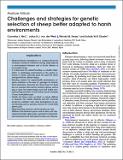Por favor, use este identificador para citar o enlazar a este item:
http://hdl.handle.net/10261/349032COMPARTIR / EXPORTAR:
 SHARE SHARE
 CORE
BASE CORE
BASE
|
|
| Visualizar otros formatos: MARC | Dublin Core | RDF | ORE | MODS | METS | DIDL | DATACITE | |

| Título: | Challenges and strategies for genetic selection of sheep better adapted to harsh environments |
Autor: | Nel, Cornelius L.; Van Der Werf, Julius H.J.; Rauw , Wendy Mercedes; Cloete, Schalk W.P. | Palabras clave: | Adaption Ovine Resilience Robustness Welfare |
Fecha de publicación: | oct-2023 | Editor: | Oxford University Press | Citación: | Animal Frontiers 13(5): 43-52 (2023) | Resumen: | Extensive sheep farming is often associated with small flocks grazing large areas, delivering limited economic returns compared with the revenue of examples such as dairy or intensive beef cattle farming. However, sheep are a popular choice of livestock in challenging environments where few other production systems are viable (Rust and Rust, 2013). Low input, extensive systems make use of the ability of ruminants to metabolize low-quality, high fiber materials that characterize pastoral grazing. By producing wool, meat, and sometimes dairy, extensive sheep production can deliver high-quality output products from a low-quality input that would otherwise have had little value for sustaining mankind. Furthermore, extensive pastoral systems can arguably be excused from some of the criticisms aimed at factory farming (Frank, 1979). Assuming sustainable stocking rates, extensive sheep farming may be favored in terms of the social and environmental concerns around animal production. However, low input systems are also associated with specific challenges. Outside the support of intensive systems, livestock are expected to survive, produce, and reproduce with little assistance from human intervention or shelter. In addition to requiring a high level of independence, they are also more exposed to the environmental elements such as harsh climates, disease, and parasite challenge. These environmental stressors directly affect production, but the implications for health and welfare should also be considered (Dwyer, 2009). Environmental intervention can be effective (Masters et al., 2023) and should aim to ensure the best outcome for animals wherever possible. In the majority of extensive systems, however, opportunities are limited for being either impractical or too expensive. Animals kept in extensive systems should thus possess an ability to adapt and cope with environmental challenges—a concern of animal breeding and genetics. The issue of adaptability has been previously reviewed according to different definitions such as the genetic selection for animal “robustness” (Rauw and Gomez-Raya, 2015) or “resilience” (Colditz and Hine, 2016; Berghof et al., 2019). The underlying concept is to achieve genetic selection of candidates most capable of withstanding or coping with environmental changes or challenges, with a desirable outcome for both performance and welfare (Rauw et al., 2021). A conceptual framework for genetic robustness was outlined by Knap (2005), and the reader interested in a wider treatment of “adaption and fitness” applied to both animal and plant species should also see the topics compiled by van der Werf et al. (2009). In extensive sheep flocks, climatic stress is a key focus of environmental adaption, and will likely become a greater concern with the effects expected from climate change (Rust and Rust, 2013). Heat stress, for example, has important implications for the well-being of ruminants (Silanikove, 2000). Accordingly, opportunities for genetic improvement of heat stress resistance has received considerable attention in the last two decades, but with the majority of studies aimed at intensive species such as dairy cattle (Pryce et al., 2022). Despite the very high level of exposure to heat stress for sheep, information on the genetic components of heat stress resistance is scarce . In turn, certain stages of the sheep reproduction cycle can also be particularly susceptible to cold stress, which has severe implications for mortality rate when lambs are born into cold, wet, and windy conditions (Donnelly, 1984). Premature death is not only a major contributor to overall reproductive wastage but also an important social concern (Dwyer, 2008). In addition to other stressors such as parasite and disease challenge, this review will address the challenges and opportunities in considering important environmental factors in genetic selection of sheep. This paper aims to (1) provide a short overview of the issues for genetic selection across variable environments; (2) consider the challenges in adapting these concepts to sheep breeding; and (3) suggest strategies promoting research and implementation, both through opportunities within existing datasets as well as in development of novel breeding objectives. | Descripción: | 10 Pág. | Versión del editor: | https://doi.org/10.1093/af/vfad055 | URI: | http://hdl.handle.net/10261/349032 | DOI: | 10.1093/af/vfad055 | ISSN: | 2160-6056 | E-ISSN: | 2160-6064 |
| Aparece en las colecciones: | (INIA) Artículos |
Ficheros en este ítem:
| Fichero | Descripción | Tamaño | Formato | |
|---|---|---|---|---|
| Challenges_and_strategies_for.pdf | artículo | 36,82 MB | Adobe PDF |  Visualizar/Abrir |
CORE Recommender
SCOPUSTM
Citations
2
checked on 29-abr-2024
Page view(s)
17
checked on 03-may-2024
Download(s)
2
checked on 03-may-2024
Google ScholarTM
Check
Altmetric
Altmetric
Este item está licenciado bajo una Licencia Creative Commons

